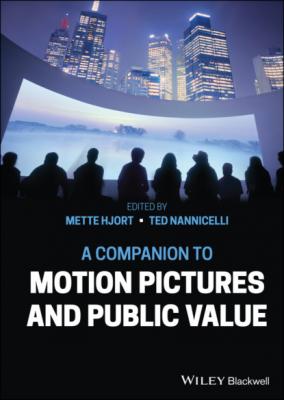A Companion to Motion Pictures and Public Value. Группа авторов
Чтение книги онлайн.
Читать онлайн книгу A Companion to Motion Pictures and Public Value - Группа авторов страница 20
 In European Visions, edited by Janelle Blankenship and Tobias Nagl, 49–64. Bielefeld: Transcript Verlag.
In European Visions, edited by Janelle Blankenship and Tobias Nagl, 49–64. Bielefeld: Transcript Verlag.23 . 2018. “Gender Equity in Screen Culture: On Susanne Bier, the Celluloid Ceiling, and the Growing Appeal of TV Production.” In Refocus: The Films of Susanne Bier, edited by Missy Molloy, Mimi Nielsen, and Meryl Shriver-Rice, 130–144. Edinburgh: Edinburgh University Press.
24 . 2020. “Activist Filmmaking in Africa, with a Focus on Cameroonian Jean-Marie Teno.” In Contemporary Radical Film Culture: Networks, Organisations and Activists, edited by Steve Presence, Mike Wayne, and Jack Newsinger, 100–112. London: Routledge.
25 Hjort Mette, and Duncan Petrie, eds. 2007. The Cinema of Small Nations. Edinburgh: University of Edinburgh Press.
26 Hurka, Thomas. 2006. “Value Theory.” In The Oxford Handbook of Ethical Theory, edited by David Copp, 357–377. Oxford: Oxford University Press.
27 Hussain, Waheed. 2018. “The Common Good.” Stanford Encyclopedia of Philosophy. https://plato.stanford.edu/cgi-bin/encyclopedia/archinfo.cgi?entry=common-good.
28 Jørgensen, Torben Beck, and Barry Bozeman. 2007. “Public Values: An Inventory.” Administration & Society 39 (3): 354–381.
29 Kirchin, Simon. 2012. Metaethics. Basingstoke: Palgrave Macmillan.
30 Klickstein, Gerald. 2009. The Musicians’ Way: A Guide to Practice, Performance and Wellness. Oxford: Oxford University Press.
31 Korsgaard, Christine. 2008. “The Dependence of Value on Humanity.” In The Practice of Value, edited by Joseph Raz, 63–85. Oxford: Oxford University Press.
32 Lewis, David. 1989. “Dispositional Theories of Value.” Proceedings of the Aristotelian Society, Supplementary Volume 63: 113–137.
33 Maggiore, Matteo. 2011. “The BBC, Public Value and Europe.” In Public Value: Theorie und Praxis im internationalen Vergleich, edited by Matthias Karmasin, Daniela Süssenbacher, and Nicole Gonser, 229–244. Heidelberg: VS Verlag.
34 Martin, Sylvia J. 2012. “Stunt Workers and Spectacle: Ethnography of Physical Risk in Hollywood and Hong Kong.” In Film and Risk, edited by Mette Hjort, 97–114. Detroit: Wayne State University Press.
35 . 2017. Haunted: An Ethnography of the Hollywood and Hong Kong Media Industries. New York: Oxford University Press.
36 Matei, Raluca, Stephen Broad, Juliet Goldbart, and Jane Ginsborg. 2018. “Health Education for Musicians.” Frontiers in Psychology 9: 1137.
37 Moore, G.E. 2004 [1903]. Principia Ethica. Mineola, NY: Dover Publications.
38 Moore, Mark H. 1995. Creating Public Value: Strategic Management in Government. Cambridge, MA: Harvard University Press.
39 . 2013. Recognizing Public Value. Cambridge, MA: Harvard University Press.
40 Mowlah, Andrew, Vivien Niblett, Jonathan Blackburn, and Marie Harris. 2014. The Value of Arts and Culture to People and Society: An Evidence Review. Arts Council England. https://www.artscouncil.org.uk/sites/default/files/download-file/Value_arts_culture_evidence_review.pdf.
41 Nagel, Thomas. 1979. “The Fragmentation of Value.” In his Mortal Questions, 128–141. Cambridge: Cambridge University Press.
42 Nagib, Lucia, Chris Perriam, and Rajinder Dudrah, eds. 2011. Theorizing World Cinema. London: I.B. Tauris.
43 Nannicelli, Ted. 2017. Appreciating the Art of Television: A Philosophical Perspective. New York: Routledge.
44 Orgeron, Devin, Marsha Orgeron, and Dan Streible, eds. 2012. Learning with the Lights Off: Educational Film. Oxford: Oxford University Press.
45 Ostherr, Kirsten. 2011. “Health Films, Cold War, and the Production of Patriotic Audiences: The Body Fights Bacteria (1948).” In Useful Cinema, edited by Charles R. Acland and Haidee Wasson, 103–124. Durham, NC: Duke University Press.
46 Parsons, Glenn, and Allen Carlson. 2008. Functional Beauty. Oxford: Oxford University Press.
47 Ponech, Trevor. 2009. “Definition of ‘Cinema’.” In The Routledge Companion to Philosophy and Film, edited by Paisley Livingston and Carl Plantinga, 52–63. New York: Routledge.
48 Presence, Steve, Mike Wayne, and Jack Newsinger, eds. 2020. Contemporary Radical Film Culture: Networks, Organisations and Activists. London: Routledge.
49 Raz, Joseph. 2008. The Practice of Value. Oxford: Clarendon Press.
50 Smith, Murray. 2006. “My Dinner with Noël; or, Can We Forget the Medium?” Film Studies: An International Review 8: 140–148.
51 Stecker, Robert. 1997. Artworks: Definition, Meaning, Value. University Park, PA: The Pennsylvania State University Press.
52 Stocker, Michael. 1990. Plural and Conflicting Values. Oxford: Clarendon Press.
53 Stone, Rob, Paul Cooke, Stephanie Dennison, and Alex Marlow-Mann, eds. 2018. The Routledge Companion to World Cinema. London: Routledge.
54 Syvertsen, Trine, and Gunn Sara Enli, eds. 2014. The Media Welfare State. Ann Arbor, MI: University of Michigan Press.
55 Thomson, Claire. 2018. Short Films for a Small Nation: Danish Informational Film 1935–1965. Edinburgh: Edinburgh University Press.
56 Wasson, Haidee. 2011. “Big, Fast Museums /Small, Slow Movies.” In Useful Cinema, edited by Charles R. Acland and Haidee Wasson, 178–204. Durham, NC: Duke University Press.
57 Watson, Gary. 1975. “Free Agency.” The Journal of Philosophy 72 (8): 205–220.
58 Wolterstorff, Nicholas. 2015. Art Rethought: The Social Practices of Art. Oxford: Oxford University Press.
PART I Artistic and Aesthetic Value
Introduction
Artistic and Aesthetic Value
Ted Nannicelli and Mette Hjort
Perhaps it will strike readers as odd that widespread acceptance of motion pictures as an art form is a relatively recent development—one that emerged out of a century-long debate about whether motion pictures could be art and, if so, under what conditions (see, e.g., Canudo [1911] 1980; Lindsay [1915] 2000; Arnheim [1933] 1957; Perkins 1972; Sesonske 1974; Scruton [1983] 2006; Carroll 1988.) With the benefit of the knowledge that movies and television were the dominant popular art forms of the 20th century, it may seem obvious that we value motion pictures as artworks and, furthermore, that this is often because of the aesthetic pleasure they afford.
However, such an apparently casual observation immediately raises a number of complex questions: On what conception of “art” and under what conditions are motion pictures artworks? What does it mean to say that we value a motion picture as an artwork, or to say that it has artistic value? How does artistic value relate to aesthetic value? And in what ways do the artistic value and aesthetic value of motion pictures depend upon things like the